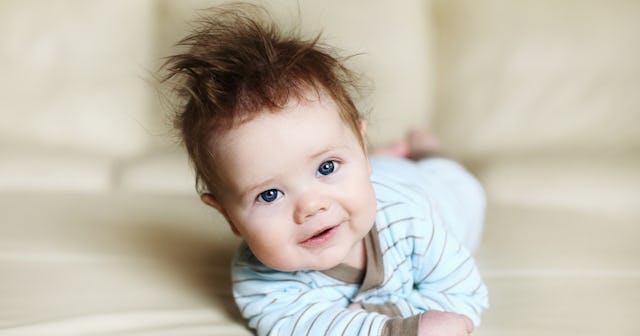Think Your Baby Has Uncontrollable Hair Syndrome? Here's How To Tell

When you’re a new mom, it’s easy to worry about everything. If there’s anything about your baby’s health that seems a bit puzzling, you want to know as soon as possible — and let’s be real, middle-of-the-night Googling does not help anyone’s motherhood anxiety. If your child’s hair is impossibly hard to style, you might find yourself panicking over the prospect of uncontrollable hair syndrome (also known as uncombable hair syndrome).
Here’s the good news: Uncontrollable hair syndrome isn’t something you should worry too much about. It’s likely that your baby is still very healthy if that’s the only malady you witness. Still, you’re a mama and you need all the info. We get it, which is why we put together this little explainer to help you discern a typical tangled head of hair from uncontrollable hair syndrome.
What is uncontrollable hair syndrome?
The syndrome is a lot like it sounds: a structural hair disorder in which hair has a frizzy, seemingly untamable appearance. It’s most common to see between infancy and age three, although some kids with uncontrollable hair syndrome may have issues up to age 12. Symptoms of uncontrollable hair syndrome include:
- The hair itself has issues with falling down, instead growing in many directions.
- The hair is hard to control with a hairbrush or any sort of product.
- Oftentimes, uncontrollable hair sprouts up as new growth, surprising parents who didn’t expect their baby’s hair to change so drastically.
How many people in the world have uncombable hair syndrome?
It’s actually hard to figure out how common uncontrollable hair syndrome is, but it’s something you likely shouldn’t worry too hard about. Only around 100 children in the world are currently diagnosed with it. However, since it’s mostly a physical issue that corrects itself with time, many families don’t necessarily go to the doctor to figure out what’s wrong. Some people don’t even know that it’s something worthy of a diagnosis — they just figure that their child has unique hair.
How hard is it to style?
It’s not known as “uncombable hair syndrome” for no reason. It’s… challenging. The hair is very quick to become matted and uncomfortable. Parents who have children that have been diagnosed often try to keep the hair out of their children’s faces, but it’s very hard to style. Oftentimes, parents need to try and use a wide-toothed comb to make sure their little one’s hair doesn’t get too knotty. Adding products to it may end up weakening the hair, so it’s important for parents to always be as gentle as possible.
Need a silver lining? Having uncontrollable hair syndrome helps set kids apart. Their hair often gets a lot of attention simply for being naturally different.
What causes uncontrollable hair syndrome?
Uncontrollable hair syndrome is caused by genetics. It’s common to pass it on through DNA. The direct cause is a gene mutation, either in the PADI3, TGM3, or TCHH genes. These genes are known to produce proteins. If there’s a mutation in one of these genes, the proteins they create don’t have quite as much activity to them, thus leading to issues showing up in a child’s hair. The strands start holding an unusual shape, making a child’s hair appear much different than that of their peers.
Is there a treatment?
Sadly, the only real treatment for older children is the onset of puberty. However, children and parents can also help lessen the severity of uncombable hair by using the right products and being as gentle as possible with follicles. Some professionals feel like taking a Biotin supplement may also help out hair, but it’s not an official cure. Oftentimes, blow-drying and heat styling aren’t recommended, as they can only cause unnecessary breakage.
Children who have uncontrollable hair syndrome may feel a little less confident than other kids, so it’s important to make sure they remember how special they are. They have a condition (that’s not permanent) that most people in the world don’t have, and they ought to be proud of it.
Did Albert Einstein have uncontrollable hair syndrome?
Well, no one really knows. Although Albert Einstein had a famously untamed crop of hair, there isn’t any concrete evidence suggesting he had uncontrollable hair syndrome. Einstein was never genetically tested for it, so there isn’t any proof. Still, his trademark wild head of hair made him the poster child for this disorder. So much so, in fact, that uncontrollable hair syndrome is also nicknamed Einstein hair.
This article was originally published on